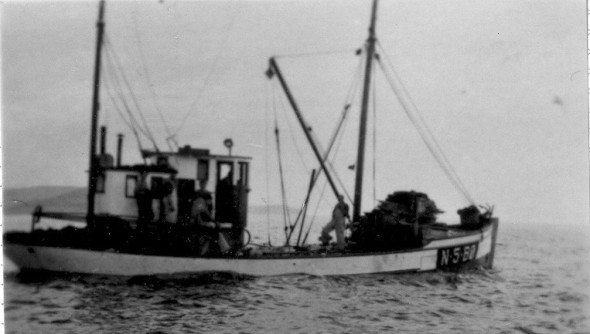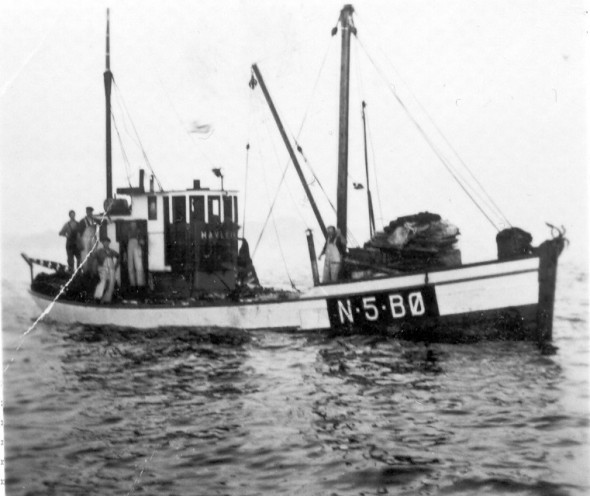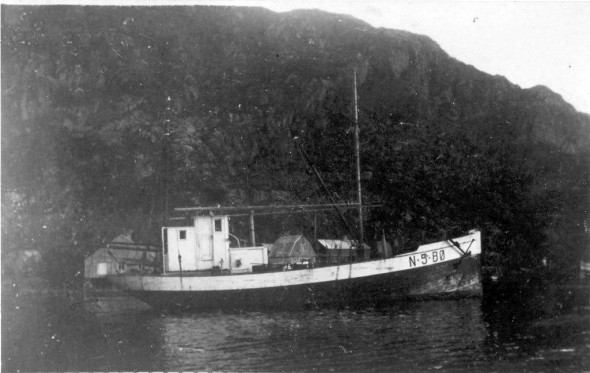“The Big 5’er” – Havleik (N-5-Bø) and my Grandfather
I guess it’s in my Viking Blood. There are few other places I feel more at home than by and – especially – on the seas! And I know at least one place where the genes ran especially salty in the family – my Grandfather, Rolv Meyer Bjugn. Today I am sailing “just for fun” as 1st Officer on the proud Danish Jagt “Klitta” where I help teaching cub scouts about the joys of The Big Blue.
I just revisited some old pictures of my grandfather and the “modern” fishing vessel – the old N-5-Bø (N-5-Boe, in case the last letter in the registration doesn’t show correctly on your screen) – HAVLEIK. They later on bought a new, bigger wooden hull fishing vessel (63 ft.) and took the same registration number – N-5-Bø and the name Havleik. The “new” Havleik was later sold. She sank after a blazing fire off the coast outside Nesseby in Varangerfjord on the 25th of March 2008 – the entire crew made it in the rafts – but that’s another story. That fire put an end to the 89 year long Havleik era.
The first Havleik
- was built in 1919, with
- a 46 feet clipper hull – width 16.2 feet
- In 1920 she was registered with a Bergsund 28 hp engine. The shipping company owning the ship at that time was registered to Peder Bjugn from Lynghaugen, Bø (Boe) in Vesteraalen.
- In 1936 she was registered with a Norwegian Wichmann 30 hp (the Wichmann was a semi-diesel engine – that is a two-stroke diesel engine).
- Havleik consists of the two Norwegian nouns “hav“, which means sea and “leik” which means “play” (or loosly translated, “joy”). Thanks to Inge M. Johansen – gamlebilderfravesteralen.origo.no – I found these older b/w photos of this classic beauty. Locally she was known as “The Big 5’er” – relating to the registration number N-5-Bø (N for Nordland – the thrid northernmost county – fylke – in Norway).

Havleik – the original vessel in the annual North-Atlantic cod fisheries outside the Lofoten Islands. My grandfather – Rolv – on the fore deck.

A good catch! 45.000 kilograms of pollock in this load. My grandfather Rolv to the left and Johan Bjugn to the right.

No more freeboard to run on! Loaded to the brink! It was always a question to make a living – not always a question of safety at sea…

Havleik – a family business. From the left Johannes Bjugn (a highly decorated officer – Lieutenant Colonel – from the first Allied Victory in WW2 – The Battle of Narvik), Leif Bjugn (a fantastically kind man and skillful fisherman), Guttorm Bjugn (former chief of police in Bø in Vesteraalen), Peder Bjugn (fisherman) and Kyrre Bjugn (telephone technician) – all highly respected men.
The End
When the new Havleik was bought – the old one was sold to Kvæfjord outside Harstad. There she laid by an old peer year after year until her hull finally sprung a leak and she sank to the bottom. She was never recovered. An immensely sad way to treat such a gemstone of proud Norwegian culture and a classically beautiful ship.
So what about the fish?
After the fish was landed by the regional fishing vessels and preserved by freeze drying (known as tørrfisk in Norwegian meaning “dried fish” – stockfish), salting and/or – salting and sun drying (known as klippfisk), the produce was loaded onto bigger vessels known as Jekter or Nordlandsjekter. These are quite similar to my vessel – the Danish Yacht Klitta – only bigger. These sailed up and down the perilous Norwegian Coast, primarily to and from Bergen. In Bergen the fish was loaded onto even larger vessels and exported to Europe. Especially Portugal, Spain and Italy has historically been huge importers of Norwegian dried and salted fish.
The North-Atlantic fish (especially the species of cod and herring) is extremely nutritious and the cold, windy climate in the winter was perfect for freeze drying fish. The fish was hung on tall wooden racks and froze while at the same time dried (a process known as sublimation). Freeze dried fish – stockfish – has been known to be edible more than 100 years after being dried…
The other main method of preserving the fish, was salting it and sun drying it on the rocks. One Norwegian word for these rocks – and the same word as the English name “cliff” is “klippe” – hence the name “klippfisk” – “cliff fish” – clipfish.
Of course – fresh fish has been a primary source of nutrition for Norwegians since long before the Viking Period. But preservation has always been necessary for storage in case the weather didn’t allow for fishing. Later on these preserved and highly nutritious “protein bombs” became important sources for proteins in the mediterranean countries like Portugal, Spain and Italy. Later on canned Norwegian fish also became hugely popular in other European countries like Great Brittain.



 ***
***
 PLEASE REMEMBER: Hit the reload button in your browser in order to see the latest predictions!!!
PLEASE REMEMBER: Hit the reload button in your browser in order to see the latest predictions!!!















